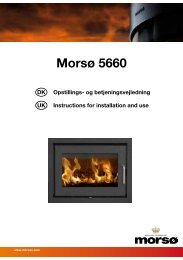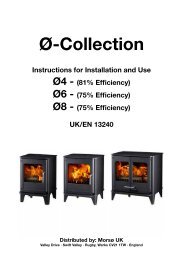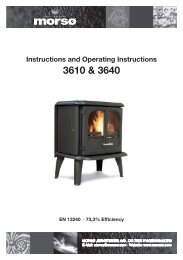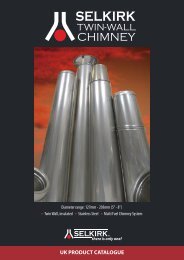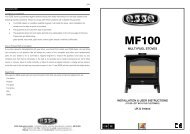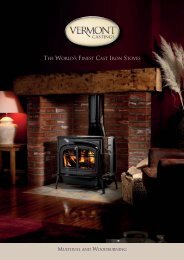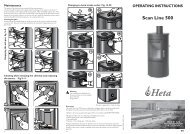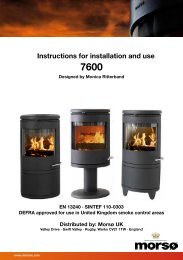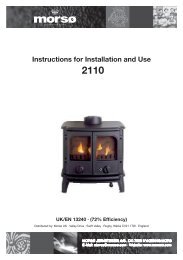You also want an ePaper? Increase the reach of your titles
YUMPU automatically turns print PDFs into web optimized ePapers that Google loves.
Thermalux<br />
The quick and simple way to create chimney breasts and install inset stoves<br />
• Easy to work: Thermalux is worked just like<br />
wood and can be cut with skill saw, jigsaw or<br />
hand saw.<br />
• Easy to join: simple to join to itself to make<br />
larger sheets or shapes<br />
• Self supporting: no need for battens or<br />
studwork<br />
• Insulating: no need for rockwool bats<br />
• Light & easy: to move and assemble<br />
• Plaster or face it: just like plasterboard<br />
Thermalux boards are used for creating chimney breasts, freestanding stove<br />
recesses and for the installation of insert stoves and can be installed using<br />
common building techniques familiar to any builder or carpenter.<br />
Thermalux boards are 50mm thick and can be be glued or screwed together to<br />
form the front section for the installation of an inset stove, or to form a whole<br />
chamber or false chimney breast. Installation is quick and simple and the<br />
sheets are self supporting, fully insulating and can be plastered.<br />
Thermalux sheets have a rough side and a smooth side, they should be used with the<br />
rough side outwards to accept the plaster.<br />
Thermalux can also be used to insulate combustible materials.<br />
Working with Thermalux<br />
When cutting Thermalux it is best to work outside as it creates dust - and wear<br />
a dust mask.<br />
Rough handling of thermalux sheets can damage the edges but any gaps, miscuts<br />
or mistakes are easily filled with thermalux adhesive/filler before<br />
plastering.<br />
Screw Fixing<br />
Use plasterboard screws or, if fixing to a masonry wall, 7.5mm star headed<br />
masonry screws.<br />
Use a cordless drill as normal and continue to drill the screw in to the sheet to<br />
countersink the head. Use Thermalux glue to fill in screw holes.<br />
There is no need to pre-drill Thermalux when fixing to walls and two pieces of<br />
Thermalux can be glued or screwed together without using rawplugs.<br />
Metal fixings transfer heat so if you are fixing Thermalux to a combustible
material then plan to place any screws at the edge of the sheet, away from the<br />
hottest part of the stove, and cover the screw heads with another strip of<br />
Thermalux.<br />
Alternatively consider using a suitable alternative like dot and dab.<br />
Remember, when using Thermalux against an inflammable surface a suitable<br />
ventilation gap should be left.<br />
Sealing<br />
Thermalux is very absorbent and so any surface that needs to be glued,<br />
plastered or dot and dabbed needs to be properly sealed first. If the sealing<br />
is not carried out effectively the plaster will craze due to the water being<br />
absorbed too quickly.<br />
Once the sheets have been cut to size then they need to be laid flat, any<br />
dust removed and a minimum of two coats of Thermalux Sealer applied to<br />
the face due to be plastered and any edge to be glued.<br />
Once the chamber has been built it is advisable to dust off and seal once<br />
again before plastering.<br />
Plastering<br />
Seal the surfaces to be plastered and fix standard corner beading to the<br />
corners.<br />
Thermalux can be plastered using ordinary gypsum plaster but we recommend<br />
using a lime-based plaster, particularly around a freestanding stove, as it will<br />
withstand heat better. Surfaces can also be plastered using a heatproof plaster<br />
if they could be subject to higher temperatures.<br />
Ensure that the plaster is left to properly dry before firing the stove - we<br />
recommend commissioning the stove before the Thermalux has been<br />
plastered.<br />
Fixing Sheets Together<br />
Thermalux kits come with 1200mm x 1200mm sheets so you will need to join<br />
two sheets to make up the sides of a chamber forming a new chimney breast.<br />
This is easily done. Thermalux glue comes ready mixed in a cartridge gun tube<br />
and can also be used to fill in small gaps and to finish joined edges.<br />
• Cut 50mm x 50mm 'battens' of Thermalux from offcuts to use as<br />
strengthening pieces.<br />
• Ensure each edge to be joined is flat and true.<br />
• Score each of the edges and brush any dust off.<br />
• Apply Sealant to each edge.<br />
• Apply glue to one edge only and spread the glue evenly.
• Push the two edges together on a flat surface (can be done in situ too).<br />
• Scrape any excess glue from the join and fill in any places where there is<br />
a visible gap. Apply a little more glue if needed for gap filling.<br />
• Fix battens across the join to hold in place while the glue dries. You can<br />
now carefully move the joined pieces so that you can fix them in place.<br />
Using Thermalux to install an inset stove<br />
Refer to the stove manufacturer's instructions for calculating chamber<br />
dimensions. There usually needs to be an air gap around the stove to allow for<br />
airflow to carry the heat away.<br />
Usually you need to ventilate the chamber with air vents at the bottom and the<br />
top to recover heat back to the room. You can incorporate the vent at the<br />
bottom into a lower log store and the vent(s) at the top can be built into the<br />
sides of the false chimney breast, or hidden behind uplighter shades.<br />
Inset boiler stoves will need an access and inspection hatch to service electric<br />
and hydraulic components. This can be built into the side of the false chimney<br />
breast or incorporated into a shelving recess.
If you are installing against a wall then insulate the back wall with Thermalux<br />
using dot and dab or screw it to the wall if it is masonry.<br />
Ceiling plate - when using twin wall insulated flue:<br />
Precut the hole for the twin wall flue pipe. Make sure you make the hole is<br />
4mm larger in diameter for expansion. When the flue goes through the hole<br />
seal that gap using a high temperature silicone sealant.<br />
The Thermalux sheet covering the ceiling should be fixed to the side sheets to<br />
avoid the need to put screws up through it into the ceiling.<br />
If you are using a twin wall flue that can be installed using solid ceiling<br />
supports (such as Selkirk STC) then fit the ceiling support as normal but with<br />
the lower plate below the thermalux (with the telescopic joist shield going up<br />
to the floor plate above)<br />
If you are using a twin wall flue that requires ventilated ceiling supports then<br />
you need to have a 'false ceiling' above the stove, then a 250mm gap before<br />
the sheet fixed against the room ceiling. That space between the two sheets<br />
needs to be ventilated. The ventilated ceiling support can then be installed.<br />
Bear in mind that metal fixings will transfer heat so, if fixing the Thermalux to<br />
a combustible wall or structure, then place screws where they will be covered<br />
over by another sheet of Thermalux, or use dot and dab or another form of<br />
suitable glue.<br />
Mark up and cut holes for stove and vent frames by simply drilling a hole in<br />
each corner and using a pad saw. Make sure to leave a gap all round for<br />
expansion of the metal. Never try to force a frame into place: offer the frame<br />
up and if the hole is too small then make it larger using a pad saw or rasp.<br />
Deliberately cutting the hole for the stove frame too small is an option which<br />
gives you a little leeway, allowing you to see the stove behind the sheet so that<br />
every cut is not just from measurements.



